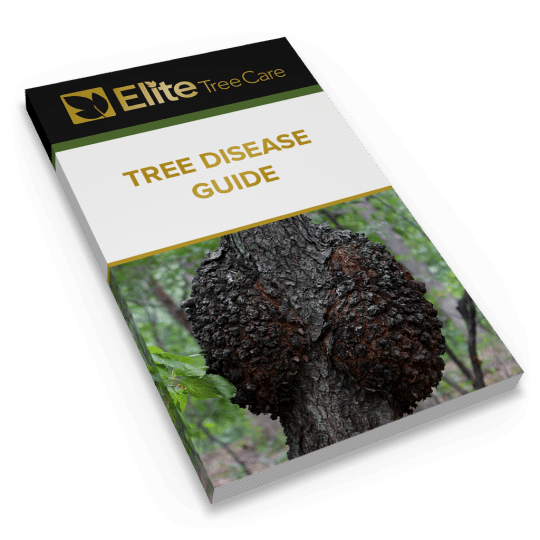Identifying Tree Diseases
Posted
July 28, 2016

Diagnose Your Tree Disease
Get a grip on what’s plaguing your tree with our visual overview of 10 common tree diseases. (Most likely, it’s a fungi.) In future blog posts, we’ll discuss treatment and control methods for tree diseases so that you can gain the upper hand in the situation.
What Causes Tree Diseases?
Witnessing the slow death of a beloved tree is sad for any homeowner, hobbyist or professional. Trees can acquire diseases, just like people and animals do.
The good news is, tree diseases don’t have to be a death sentence, if they are stopped in time. Many diseases can be treated as soon as the bacterial or fungal culprit is identified. For serious cases, you should hire a professional to treat the tree or, if it’s too late, remove it from your landscape before it becomes a hazard.
Common Tree Diseases in Pennsylvania
Here are some of the tree diseases most common to Pennsylvania.
Leaf Diseases
- Decidious trees, those that lose their leaves seasonally, can develop leaf spot diseases. These tree diseases debilitate trees and shrubs by interrupting photosynthesis, the process by which plants creates food and energy.
- Anthracnose – Anthracnose is caused by a group of fungus species. In Pennsylvania, it most often affects ash, oak, sycamore, maple and dogwood trees. Symptoms include leaf spots, blotches or distortion, especially along leaf veins, defoliation, shoot blight, twig cankers and dieback. A sure-fire way to determine if your tree suffers from this is to use a magnifying glass to examine the underside of an infected leaf. You will see pimple-like fungal fruiting structures, especially along the leaf veins. Fortunately, most of the time, anthracnose does not cause long term damage to established trees. But repeated infections with anthracnose over consecutive years will reduce the tree’s health and leave it vulnerable to other pests and infections.
Bark and Trunk Diseases
- Beech Bark Disease affects beech trees and is caused by the combination of a beech scale insect’s feeding habits and an opportunistic fungal pathogen. An early sign of beech bark disease is a visible infection on the tree’s bark that looks like a reddish-brown, oozing, bleeding wound. (Yuck!) Other symptoms of the disease include small, sparse, yellow foliage, and a thin, weak crown.
- Thousand Cankers Disease – Like the beech bark disease, thousand cankers disease is caused by a bug/fungus double whammy. A tiny bark beetle creates galleries and tunnels beneath the bark of the tree and paves the way for a fungal infection and cankers. The three primary symptoms of this disease are dead branches, many small cankers on branches and the trunk, and evidence of tiny bark beetles. The bark surface may not seem affected, or a dark amber stain or cracking of the bark may appear directly above a canker.
- Dutch Elm Disease – Dutch Elm Disease destroys the American elm tree and some other elm species. It is caused by a fungus that infects the vascular (circulatory) system of the tree. The fungus clogs vascular tissues, prevents water movement to the crown and causes the tree to wilt and die. Initially, the disease will affect individual branches, causing leaves to yellow and curl up. Within one to three years, it will choke and kill the entire tree.
Root diseases
- Root Rot – Armillaria root rot is a fungal disease affecting hundreds of species of trees and fruit and vegetable plants. Oak and dogwood trees are particularly vulnerable to the fungus. It’s most common when soil remains wet for long periods. Symptoms may not be immediately evident; the tree may decline gradually over a few years. Leaves may turn a dull green, yellow, red, or purple as they wilt. The bark of infected trees may appear darkened around the soil line. Peeling away some bark should reveal red-brown discoloration underneath.
- Black Knot – Black knot is a disfiguring and ultimately deadly disease that infects stone fruit trees, particularly plum and cherry trees. It’s caused by the fungus Apiosporina morbosa. Black knot’s presence is most obvious in winter when there are no leaves to hide the fungus’ trademark bulbous, warty black masses on tree branches. The mass usually encircles the stem, and it can range from an inch to nearly a foot in length. Older knots can become infested and covered with a pinkish-white mold.
Preventing Tree Diseases
Avoid tree diseases by educating yourself on the common types of problems in your geographic location. Purchase and plant trees that are resistant to the area’s problematic agricultural diseases. And as always, practice good tree care maintenance. Regularly monitor the tree’s fertilizer, light, soil, and watering conditions, and you will help keep disease at bay.
Ask the Experts about Tree Diseases
If you have any questions or want help bringing your beloved tree back to its full glory, contact Elite Tree Service at 610-935-2279.

Download Your FREE Tree Disease Guide
Get a grip on what’s plaguing your tree with our visual overview of common tree diseases. (Most likely, it’s a fungus.)